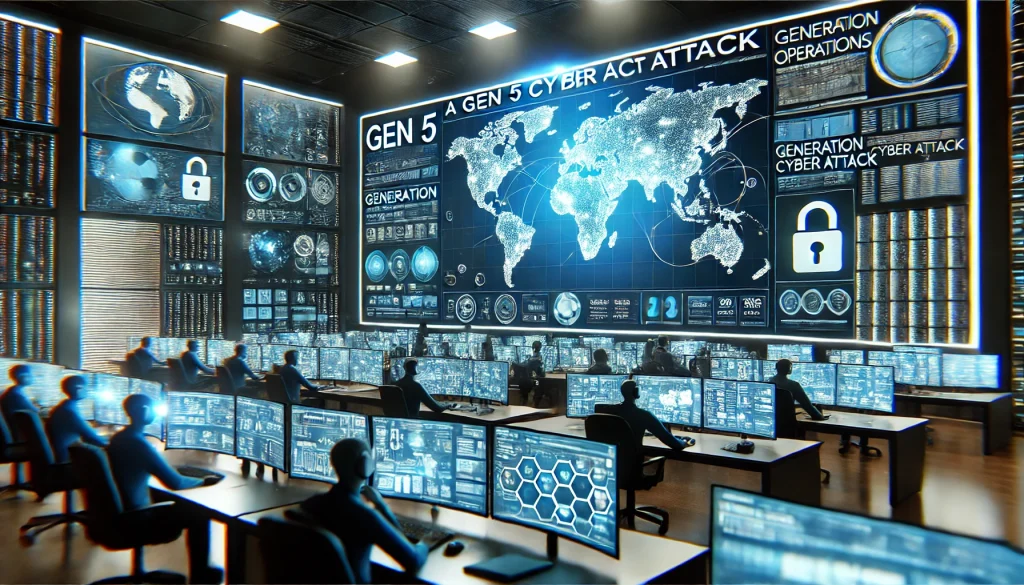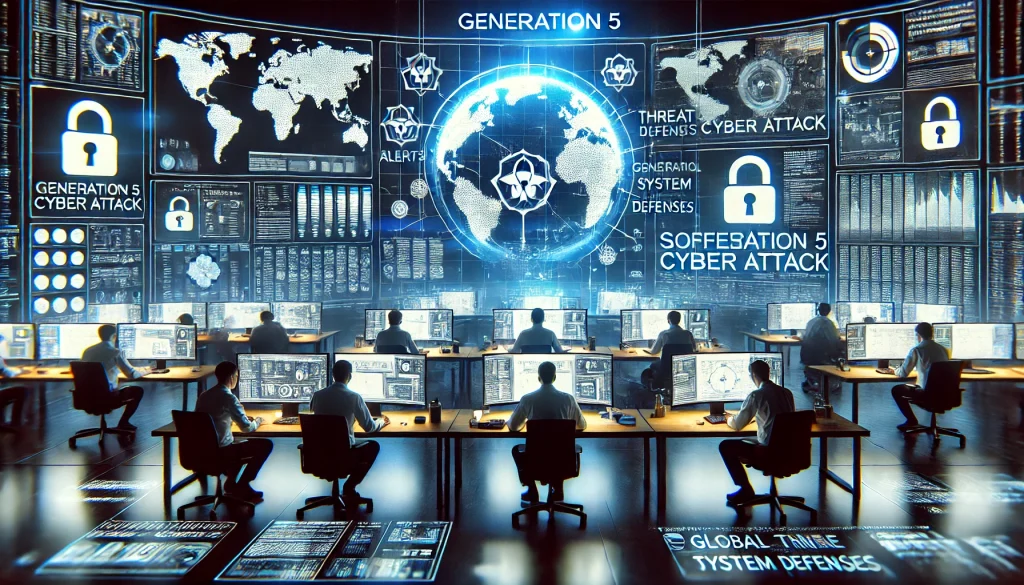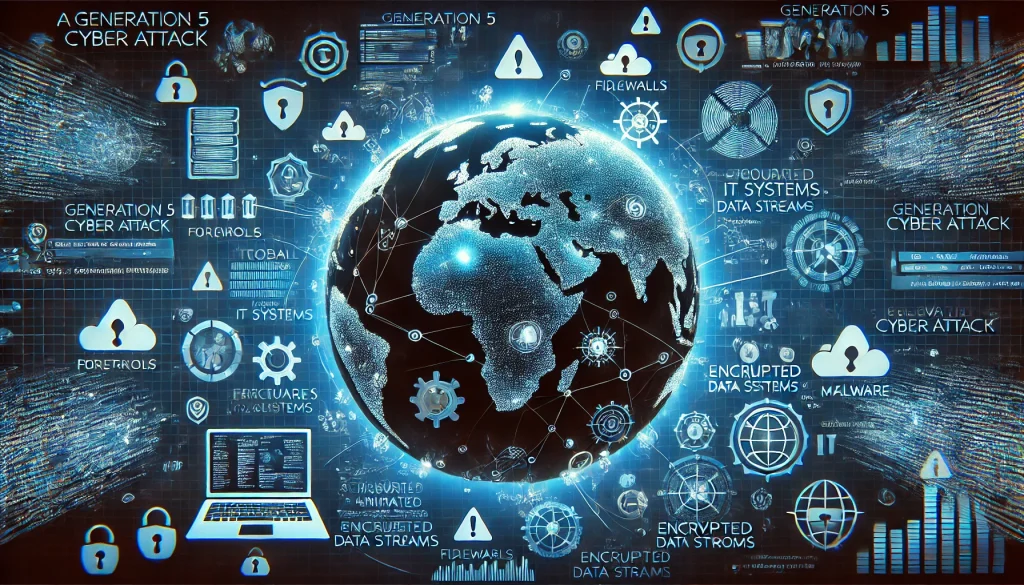
Overview
In October 2024, cybersecurity concerns have never been more pressing, especially with the rise of Gen 5 cyber attack. These fifth-generation attacks are sophisticated, large-scale, and increasingly challenging to defend against. Unlike their predecessors, Gen 5 cyber attack leverage modern technology to strike across multiple vectors, often bypassing traditional defenses with ease.
Given the frequency of cyber incidents, such as WannaCry and NotPetya, Gen 5 attacks highlight the evolving nature of cybersecurity risks. For organizations and individuals alike, understanding the workings of these advanced attacks is critical to maintaining security in today’s digital landscape. From small businesses to major corporations, no one is immune. As we explore the components of these attacks, their impact, and what steps can be taken for prevention, the relevance of this topic becomes apparent to every digital user and business owner.
How Gen 5 cyber attack Work?
Gen 5 cyber attack are multi-vector, meaning they strike through several entry points at once, making detection and response more complicated. These attacks are primarily zero-day exploits, meaning they leverage previously unknown vulnerabilities in software and systems. Traditional antivirus software and firewalls are often ineffective against these types of threats. Attackers have grown bolder by using artificial intelligence (AI) and machine learning (ML) to anticipate security measures, automating their attacks to reach unprecedented scales.
By exploiting vulnerabilities in cloud environments, Internet of Things (IoT) devices, and mobile networks, Gen 5 attackers bypass older generation security measures, which typically focus on single vectors or perimeters. For example, a hacker could breach an organization’s firewall while simultaneously planting malware on an employee’s mobile device. This interconnectedness, driven by rapid digital transformation, is one of the primary factors enabling Gen 5 attacks to thrive.
Examples of Notable Gen 5 Attacks

Several high-profile cyber incidents have served as examples of Gen 5 attacks in recent years:
- WannaCry (2017): A ransomware attack that affected over 200,000 computers globally, WannaCry used a vulnerability in Microsoft Windows, encrypting files and demanding ransom payments in Bitcoin. This attack highlighted the widespread risk associated with unpatched software and served as a precursor to the multi-vector nature of Gen 5 attacks.
- NotPetya (2017): Another devastating ransomware attack, NotPetya initially masqueraded as a financial software update. Once inside corporate networks, it spread rapidly, encrypting data and locking users out of their systems. NotPetya caused billions in damages, mainly hitting organizations in finance, healthcare, and shipping.
These incidents illustrate the complexity of Gen 5 attacks, which are not only disruptive but also have long-term financial and reputational consequences for organizations.
Impact of Gen 5 cyber attack on Businesses
The business landscape is particularly vulnerable to Gen 5 cyber attack. With so many companies migrating to the cloud and adopting mobile technologies, the attack surface has grown exponentially. Gen 5 attacks exploit this expanded surface, hitting organizations where they are most vulnerable. The consequences include:
- Financial Losses: A successful attack can result in immediate financial losses due to theft or ransom demands. Moreover, there are indirect costs such as operational downtime and recovery expenses.
- Reputational Damage: Businesses that fall victim to Gen 5 attacks often suffer from a loss of customer trust, which can be far more difficult to repair than financial losses. A breach exposes sensitive customer data, leading to brand degradation and loss of client confidence.
- Operational Disruption: With attacks such as NotPetya, businesses face days or even weeks of downtime. This disruption not only stalls productivity but can also affect supply chains and critical operations.
- Regulatory Fines: As data protection laws tighten globally, companies are at risk of incurring hefty fines if they fail to safeguard their data. The General Data Protection Regulation (GDPR) and other regulations make it crucial for businesses to avoid breaches or face financial penalties.
Prevention Strategies for Gen 5 cyber attack

While Gen 5 cyber attack are more advanced than previous generations, there are several prevention strategies that businesses and individuals can adopt:
- Adopt Advanced Threat Prevention Technologies: To guard against zero-day vulnerabilities and multi-vector attacks, organizations must upgrade their security measures beyond traditional solutions. Tools such as endpoint detection and response (EDR), sandboxing, and advanced firewalls are essential in combating Gen 5 threats. Solutions that integrate AI and ML for real-time threat detection are becoming increasingly necessary.
- Employee Training and Awareness: Cybersecurity is only as strong as its weakest link, which is often human error. Regular training programs should be implemented to teach employees about phishing schemes, password security, and the importance of updating software regularly. By raising awareness, companies can mitigate the risk of falling prey to social engineering tactics.
- Patch Management and Regular Updates: Many cyber attacks exploit vulnerabilities in outdated software or systems. Regularly patching and updating software is a simple yet effective way to close security gaps. Automatic updates should be enabled across all devices to ensure that no loopholes are left unaddressed.
- Segmentation of Networks: Isolating different parts of a network can prevent an attacker from moving laterally across the system if they gain access to one section. Implementing Zero Trust Architecture (ZTA), where each device and user must continuously verify their credentials, can significantly reduce the chances of a breach.
- Cloud Security Measures: As more businesses move to the cloud, securing these environments is paramount. End-to-end encryption, two-factor authentication (2FA), and stringent access control policies are crucial in protecting cloud assets from cyber threats.
Future Outlook of Gen 5 cyber attack
The future of cyber warfare points to a rise in more sophisticated and damaging Gen 5 cyber attack. As technology continues to advance, so too will the methods cybercriminals use. Quantum computing, for instance, could potentially break encryption methods that are currently deemed secure, opening up new avenues for attack.
However, organizations and cybersecurity professionals are not defenseless. The development of quantum encryption and the continuous evolution of AI-based defense systems will likely shape the future of cybersecurity. Additionally, governments and international bodies are increasingly stepping in, creating global frameworks for cooperation in tackling cyber threats, making it harder for cybercriminals to operate across borders.
Conclusion
In the fast-paced digital world of October 2024, Gen 5 cyber attack have become one of the most pressing threats to businesses and individuals alike. As cybercriminals exploit the vulnerabilities in our interconnected systems, it is crucial for organizations to adopt advanced security measures, stay informed, and remain vigilant. These attacks are not going away anytime soon—in fact, they are likely to become even more sophisticated.
By investing in cutting-edge technologies, training employees, and keeping up with the latest cybersecurity trends, businesses can mitigate the risk of falling victim to these types of attacks. The cost of prevention is far less than the cost of recovery after a breach. As we move forward, maintaining a proactive approach to cybersecurity will be essential in safeguarding digital assets from these multifaceted threats.
Key Takeaways
- Gen 5 cyber attack are multi-vector, advanced threats that can bypass traditional security measures.
- High-profile attacks like WannaCry and NotPetya serve as examples of the damage these cyber incidents can cause.
- Prevention requires advanced technologies, regular updates, and employee awareness to guard against this ever-evolving threat.
Resources
- Check Firewalls. Gen V Cyber Security: The Next Frontier.
- Check Point. Gen V Cyber Security: What You Need to Know.
- Forbes. How Are 5th and 6th Generation Cyberattacks Different from Previous Ones?.
- TechTarget. Gen V Attacks: The Next Cybersecurity Problem.
- World Economic Forum. Fifth-Generation Cyberattacks: The Next Wave.
